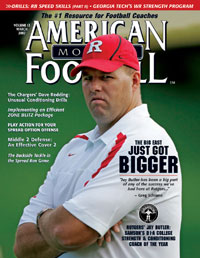AMERICAN FOOTBALL MONTHLY THE #1 RESOURCE FOR FOOTBALL COACHES
Article CategoriesAFM Magazine
|
Here There be Tygers - A Look at the Tyger OffenseA hybrid spread offense utilizing five receiversby: Heath Hamrick Rio Vista High School, Rio Vista, TX by: Todd Allen The Colony HIgh School, The Colony, TX © More from this issue In the years before adventure died and exploration became pointless, maps were filled to bursting with blank spaces where the roads stopped, mountain chains disappeared, and no flag claimed sovereignty. In these spaces European cartographers placed one phrase: Here there be Tygers. It was a warning; the territory so marked was virtually unexplored and potentially dangerous. As we wrote this article, it became clear that we had stumbled onto such a territory. In Coaching the Spread Bone Offense: Spread the Field, we outlined a hybrid offense designed to wed the spread’s precision passing game with a running attack based on the misdirection and multiple ball carriers of the Wing-T; utilizing a double slot set as the base formation for our offense, we were able to achieve this goal (a sample, the Short Trap series, can be....The full article can only be seen by subscribers. Subscribe today!
|
|
|||||||
| HOME |
MAGAZINE |
SUBSCRIBE | ONLINE COLUMNISTS | COACHING VIDEOS |
Copyright 2026, AmericanFootballMonthly.com
All Rights Reserved





